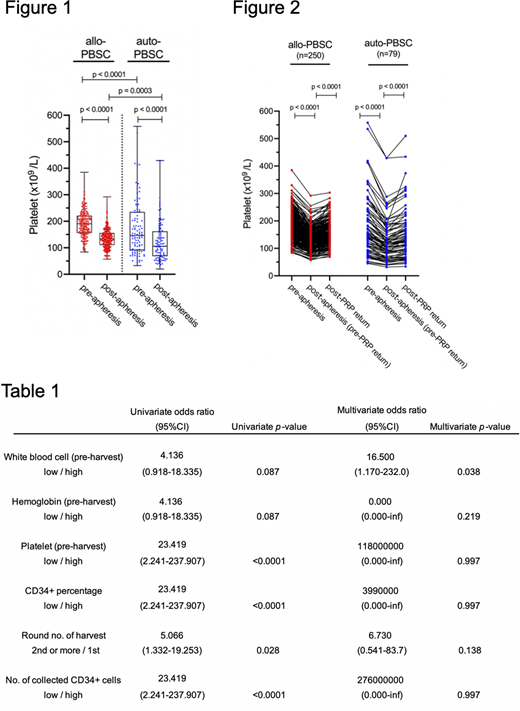Peripheral blood stem cell (PBSC) transplantation is a key treatment option for hematological diseases and widely performed in clinical practice. Platelet loss is the major complication of PBSC apheresis, and platelet-rich plasma (PRP) return is recommended in case of severe platelet decrease following apheresis; however, little is known about the frequency and severity of platelet loss nor the efficacy of PRP return post-apheresis. To address these questions, we assessed changes in platelet counts following PBSC-related apheresis in 270 allogeneic (allo)- and 105 autologous (auto)-PBSC settings. We also evaluated efficacy of PRP transfusion on platelet recovery post-apheresis.
Platelet counts reduced up to 70% post-apheresis in both allo- and auto-PBSC settings, while severe platelet count decrease (< 50 x 109/L) was only observed in auto-PBSC patients (Figure 1).
We next analyzed the relationship between severe platelet (< 50 x 109/L) after apheresis and several clinical factors by using univariate and multivariate analysis for auto-PBSC patients. As shown in Table 1, in univariate analysis, severe platelet counts following auto-PBSC apheresis was found more frequently in patients with lower platelet count, lower percentage of CD34+ cells in PB at pre-apheresis, repeated round of apheresis, and smaller number of collected CD34+ cells. On the other hand, in multivariate analysis, the white blood cell (WBC) counts pre-apheresis was the only significant risk factor of severe platelet count following apheresis (p = 0.038).
We finally analyzed the transitions of platelet counts in the setting of apheresis. The median platelet counts at pre-apheresis, post-apheresis, and post-PRP return were 187.0 x 109/L, 132.0 x 109/L, and 154.0 x 109/L for allo-PBSC apheresis, and 147.0 x 109/L, 111.0 x 109/L, and 127.0 x 109/L for auto-PBSC apheresis (p < 0.0001 for all, allo-PBSC donors and auto-PBSC patients, respectively) (Figure 2), indicating that PRP return post-apheresis facilitated a rapid platelet recovery in both allo- and auto-settings.
Collectively, our data suggest that WBC counts pre-apheresis is a useful predictor for severe platelet decrease following auto-PBSC apheresis and that PRP return is an effective mean to facilitate platelet recovery post-apheresis.
No relevant conflicts of interest to declare.
Author notes
Asterisk with author names denotes non-ASH members.


This feature is available to Subscribers Only
Sign In or Create an Account Close Modal